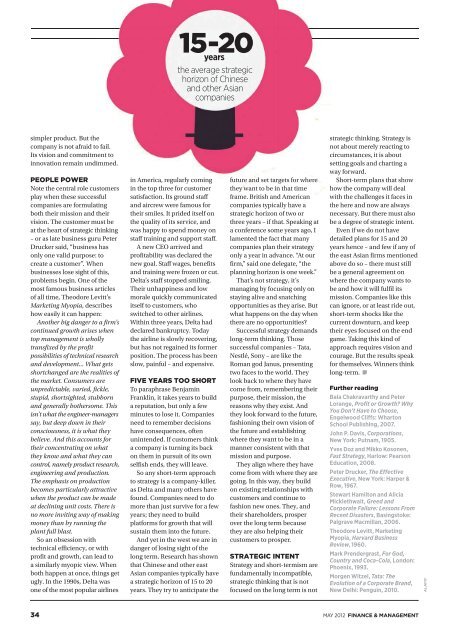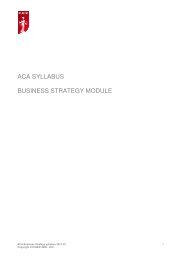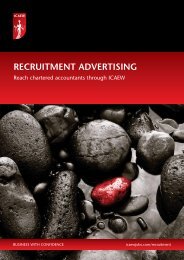Hit the road Positive leadership for troubled times - ICAEW
Hit the road Positive leadership for troubled times - ICAEW
Hit the road Positive leadership for troubled times - ICAEW
Create successful ePaper yourself
Turn your PDF publications into a flip-book with our unique Google optimized e-Paper software.
15-20years<br />
years<br />
<strong>the</strong> average strategic<br />
horizon of Chinese<br />
and o<strong>the</strong>r Asian<br />
companies<br />
simpler product. But <strong>the</strong><br />
company is not afraid to fail.<br />
Its vision and commitment to<br />
innovation remain undimmed.<br />
PEOPLE POWER<br />
Note <strong>the</strong> central role customers<br />
play when <strong>the</strong>se successful<br />
companies are <strong>for</strong>mulating<br />
both <strong>the</strong>ir mission and <strong>the</strong>ir<br />
vision. The customer must be<br />
at <strong>the</strong> heart of strategic thinking<br />
– or as late business guru Peter<br />
Drucker said, “business has<br />
only one valid purpose: to<br />
create a customer”. When<br />
businesses lose sight of this,<br />
problems begin. One of <strong>the</strong><br />
most famous business articles<br />
of all time, Theodore Levitt’s<br />
Marketing Myopia, describes<br />
how easily it can happen:<br />
Ano<strong>the</strong>r big danger to a firm’s<br />
continued growth arises when<br />
top management is wholly<br />
transfixed by <strong>the</strong> profit<br />
possibilities of technical research<br />
and development... What gets<br />
shortchanged are <strong>the</strong> realities of<br />
<strong>the</strong> market. Consumers are<br />
unpredictable, varied, fickle,<br />
stupid, shortsighted, stubborn<br />
and generally bo<strong>the</strong>rsome. This<br />
isn’t what <strong>the</strong> engineer-managers<br />
say, but deep down in <strong>the</strong>ir<br />
consciousness, it is what <strong>the</strong>y<br />
believe. And this accounts <strong>for</strong><br />
<strong>the</strong>ir concentrating on what<br />
<strong>the</strong>y know and what <strong>the</strong>y can<br />
control, namely product research,<br />
engineering and production.<br />
The emphasis on production<br />
becomes particularly attractive<br />
when <strong>the</strong> product can be made<br />
at declining unit costs. There is<br />
no more inviting way of making<br />
money than by running <strong>the</strong><br />
plant full blast.<br />
So an obsession with<br />
technical efficiency, or with<br />
profit and growth, can lead to<br />
a similarly myopic view. When<br />
both happen at once, things get<br />
ugly. In <strong>the</strong> 1990s, Delta was<br />
one of <strong>the</strong> most popular airlines<br />
in America, regularly coming<br />
in <strong>the</strong> top three <strong>for</strong> customer<br />
satisfaction. Its ground staff<br />
and aircrew were famous <strong>for</strong><br />
<strong>the</strong>ir smiles. It prided itself on<br />
<strong>the</strong> quality of its service, and<br />
was happy to spend money on<br />
staff training and support staff.<br />
A new CEO arrived and<br />
profitability was declared <strong>the</strong><br />
new goal. Staff wages, benefits<br />
and training were frozen or cut.<br />
Delta’s staff stopped smiling.<br />
Their unhappiness and low<br />
morale quickly communicated<br />
itself to customers, who<br />
switched to o<strong>the</strong>r airlines.<br />
Within three years, Delta had<br />
declared bankruptcy. Today<br />
<strong>the</strong> airline is slowly recovering,<br />
but has not regained its <strong>for</strong>mer<br />
position. The process has been<br />
slow, painful – and expensive.<br />
FIVE YEARS TOO SHORT<br />
To paraphrase Benjamin<br />
Franklin, it takes years to build<br />
a reputation, but only a few<br />
minutes to lose it. Companies<br />
need to remember decisions<br />
have consequences, often<br />
unintended. If customers think<br />
a company is turning its back<br />
on <strong>the</strong>m in pursuit of its own<br />
selfish ends, <strong>the</strong>y will leave.<br />
So any short-term approach<br />
to strategy is a company-killer,<br />
as Delta and many o<strong>the</strong>rs have<br />
found. Companies need to do<br />
more than just survive <strong>for</strong> a few<br />
years; <strong>the</strong>y need to build<br />
plat<strong>for</strong>ms <strong>for</strong> growth that will<br />
sustain <strong>the</strong>m into <strong>the</strong> future.<br />
And yet in <strong>the</strong> west we are in<br />
danger of losing sight of <strong>the</strong><br />
long term. Research has shown<br />
that Chinese and o<strong>the</strong>r east<br />
Asian companies typically have<br />
a strategic horizon of 15 to 20<br />
years. They try to anticipate <strong>the</strong><br />
future and set targets <strong>for</strong> where<br />
<strong>the</strong>y want to be in that time<br />
frame. British and American<br />
companies typically have a<br />
strategic horizon of two or<br />
three years – if that. Speaking at<br />
a conference some years ago, I<br />
lamented <strong>the</strong> fact that many<br />
companies plan <strong>the</strong>ir strategy<br />
only a year in advance. “At our<br />
firm,” said one delegate, “<strong>the</strong><br />
planning horizon is one week.”<br />
That’s not strategy, it’s<br />
managing by focusing only on<br />
staying alive and snatching<br />
opportunities as <strong>the</strong>y arise. But<br />
what happens on <strong>the</strong> day when<br />
<strong>the</strong>re are no opportunities?<br />
Successful strategy demands<br />
long-term thinking. Those<br />
successful companies – Tata,<br />
Nestlé, Sony – are like <strong>the</strong><br />
Roman god Janus, presenting<br />
two faces to <strong>the</strong> world. They<br />
look back to where <strong>the</strong>y have<br />
come from, remembering <strong>the</strong>ir<br />
purpose, <strong>the</strong>ir mission, <strong>the</strong><br />
reasons why <strong>the</strong>y exist. And<br />
<strong>the</strong>y look <strong>for</strong>ward to <strong>the</strong> future,<br />
fashioning <strong>the</strong>ir own vision of<br />
<strong>the</strong> future and establishing<br />
where <strong>the</strong>y want to be in a<br />
manner consistent with that<br />
mission and purpose.<br />
They align where <strong>the</strong>y have<br />
come from with where <strong>the</strong>y are<br />
going. In this way, <strong>the</strong>y build<br />
on existing relationships with<br />
customers and continue to<br />
fashion new ones. They, and<br />
<strong>the</strong>ir shareholders, prosper<br />
over <strong>the</strong> long term because<br />
<strong>the</strong>y are also helping <strong>the</strong>ir<br />
customers to prosper.<br />
STRATEGIC INTENT<br />
Strategy and short-termism are<br />
fundamentally incompatible,<br />
strategic thinking that is not<br />
focused on <strong>the</strong> long term is not<br />
strategic thinking. Strategy is<br />
not about merely reacting to<br />
circumstances, it is about<br />
setting goals and charting a<br />
way <strong>for</strong>ward.<br />
Short-term plans that show<br />
how <strong>the</strong> company will deal<br />
with <strong>the</strong> challenges it faces in<br />
<strong>the</strong> here and now are always<br />
necessary. But <strong>the</strong>re must also<br />
be a degree of strategic intent.<br />
Even if we do not have<br />
detailed plans <strong>for</strong> 15 and 20<br />
years hence – and few if any of<br />
<strong>the</strong> east Asian firms mentioned<br />
above do so – <strong>the</strong>re must still<br />
be a general agreement on<br />
where <strong>the</strong> company wants to<br />
be and how it will fulfil its<br />
mission. Companies like this<br />
can ignore, or at least ride out,<br />
short-term shocks like <strong>the</strong><br />
current downturn, and keep<br />
<strong>the</strong>ir eyes focused on <strong>the</strong> end<br />
game. Taking this kind of<br />
approach requires vision and<br />
courage. But <strong>the</strong> results speak<br />
<strong>for</strong> <strong>the</strong>mselves. Winners think<br />
long-term.<br />
Fur<strong>the</strong>r reading<br />
Bala Chakravarthy and Peter<br />
Lorange, Profit or Growth? Why<br />
You Don’t Have to Choose,<br />
Engelwood Cliffs: Wharton<br />
School Publishing, 2007.<br />
John P. Davis, Corporations,<br />
New York: Putnam, 1905.<br />
Yves Doz and Mikko Kosonen,<br />
Fast Strategy, Harlow: Pearson<br />
Education, 2008.<br />
Peter Drucker, The Effective<br />
Executive, New York: Harper &<br />
Row, 1967.<br />
Stewart Hamilton and Alicia<br />
Micklethwait, Greed and<br />
Corporate Failure: Lessons From<br />
Recent Disasters, Basingstoke:<br />
Palgrave Macmillan, 2006.<br />
Theodore Levitt, Marketing<br />
Myopia, Harvard Business<br />
Review, 1960.<br />
Mark Prendergrast, For God,<br />
Country and Coca-Cola, London:<br />
Phoenix, 1993.<br />
Morgen Witzel, Tata: The<br />
Evolution of a Corporate Brand,<br />
New Delhi: Penguin, 2010.<br />
ALAMY<br />
34 MAY 2012 FINANCE & MANAGEMENT

















